How to make Beet Kvass! An Eastern European probiotic drink made with fresh beets, sea salt and water. Full of healthy probiotics from Lacto-fermentation, these good bacteria heal the gut and support immunity.
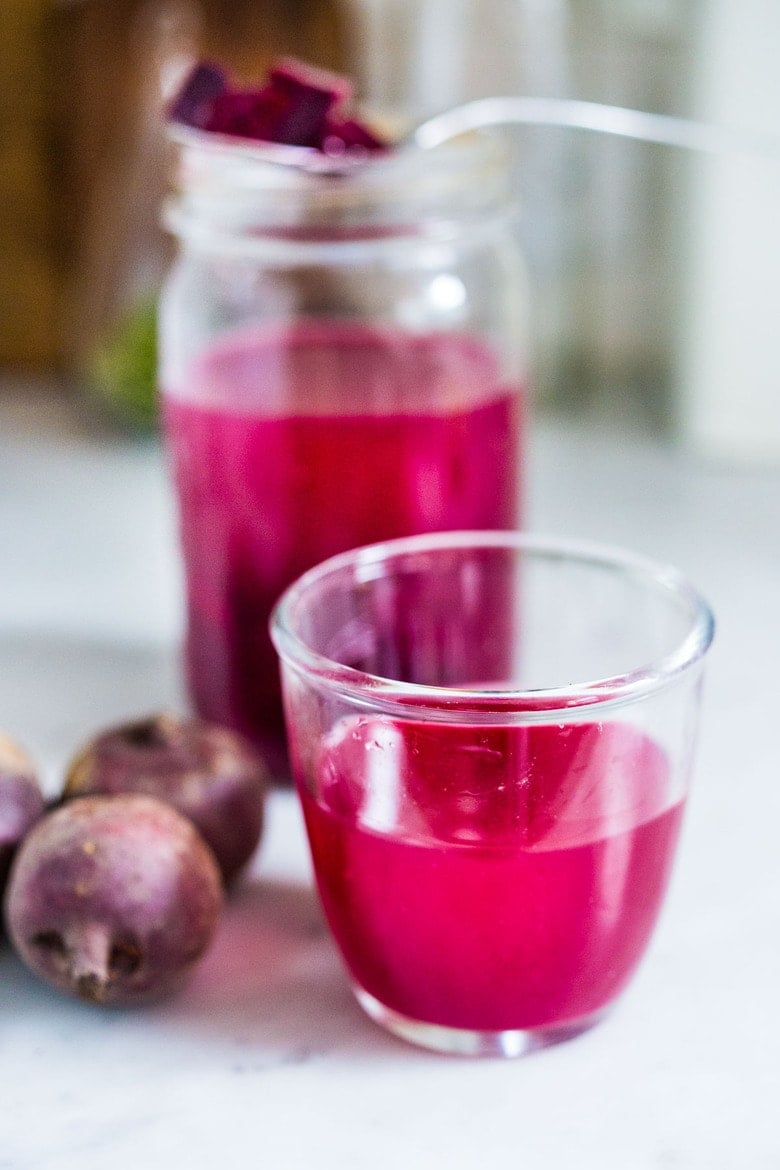
Here is a fun little recipe I’ve been playing around with for years now- Beet Kvass! Beet kvass is a fermented probiotic drink that hails from Eastern Europe that is tangy, earthy, salty and slightly sweet from the beets. Full of gut-healthy probiotics, it’s a simple way to add diversity to our microbiome and, in turn, support our immune system.
It differs from Kombucha or Water Kefir in that this fermented drink is savory and briny, made with salt, rather than sugar, more like our gut shot or pickle brine.
Why you’ll love Beet Kvass
- Easy to make– takes 15 minutes of hands-on time before letting mother nature take its course!
- Made with simple ingredients– just beets, salt and water!
- Gut Supporting! Filled with billions of healthy probiotics in just one tablespoon!
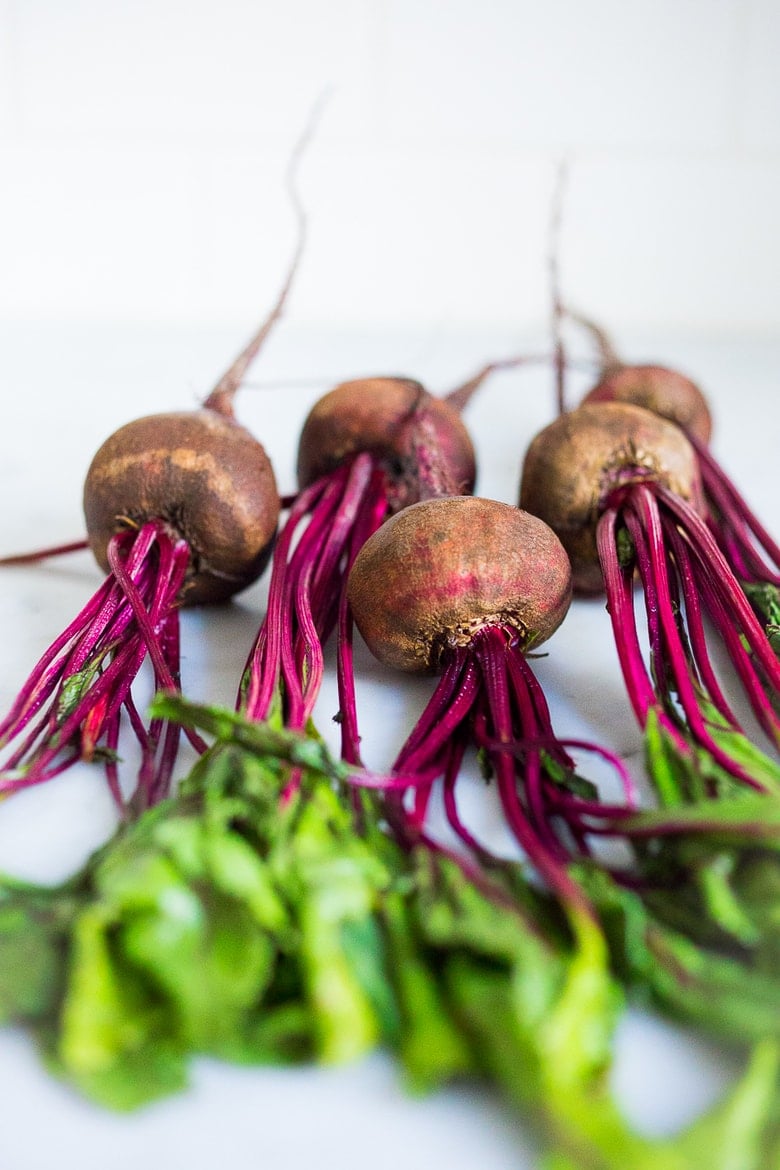 Kvass Ingredients
Kvass Ingredients
- organic beets- I love the color of red beets, but yellow beets works fine too! Use organic, unpeeled beets.
- fine sea salt- you want to use natural, unprocessed salt when fermenting.
- filtered water- chlorine in tap water can suppress fermentation, so use filtered if possible.
EXPERT TIP: To shorten the fermentation process, you can also add 1- 2 tablespoons of whey (the liquid from straining yogurt) or liquid from fermented kraut or pickle brine (the kind from alive cultures- in the refrigerated section of the grocery store, or homemade.)
Optional Beet Kvass Flavorings
- fresh dill (or fennel fronds), bay leaves, or other herbs.
- pickling spices (fennel seed, dill seed, peppercorns, celery seeds, caraway, etc) to prevent from floating, add them to the jar first.
- sliced onion and/or garlic.
- fresh sliced ginger or turmeric root.
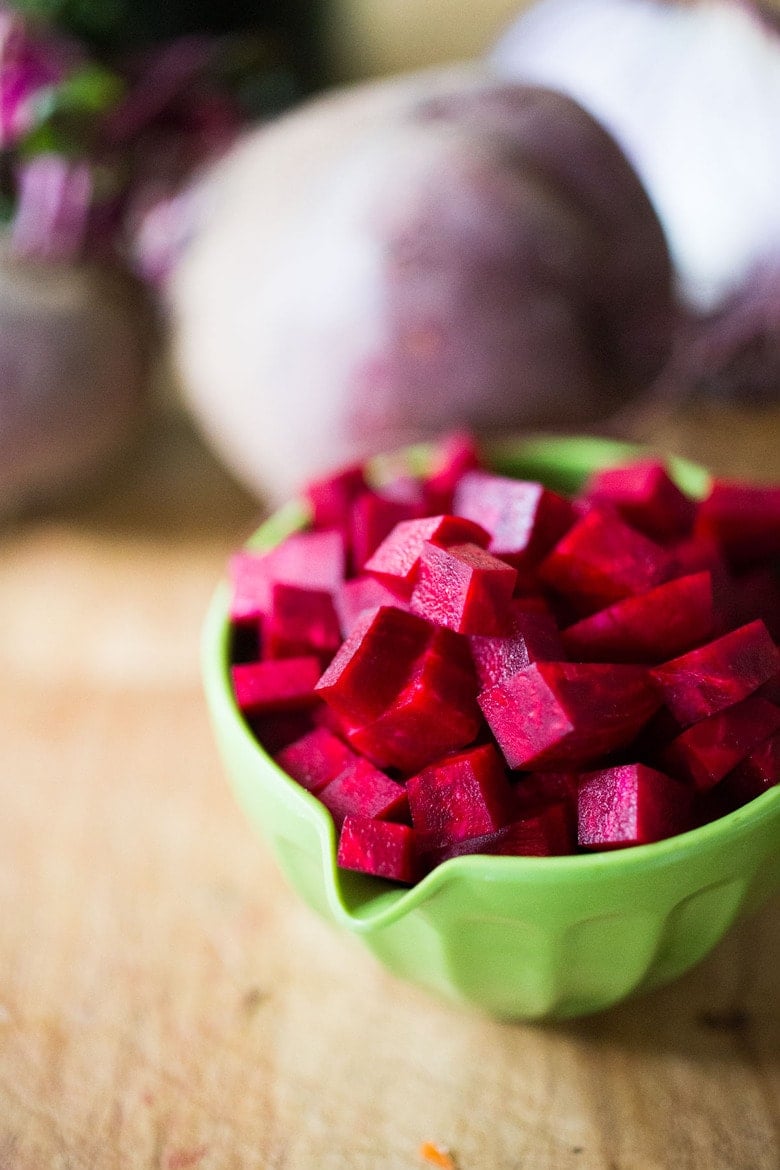
How to make Beet Kvass (instructions)
- Prep: Rinse and slice the beets into ¼-inch thick rounds, then dice them, leaving the skin on. You want that bacteria from the skin, so don’t peel! Get a clean, 1-quart mason jar.
- Assemble: If adding any whole spices, add these to the jar first, then add garlic, onion or dill if using. Add all the beets overtop. If adding whey, kraut brine or pickle brine, add this now.
- Make the brine: Mix 3 cups water with 1 heaping tablespoon sea salt. Pour this into the jar, leaving an inch of headroom at the top. If you need more brine: the ratio is 1 heaping teaspoon of salt, per 1 cup of water. Mix it first, then add. The salt will kill the harmful bacteria, but allow the healthy lactobacilli to flourish.
- Remove any spices or seeds that float to the top. Anything that touches the surface can mold. I check daily for floaters! Cover with a loose-fitting lid. Place in a bowl or baking dish (to collect any overflow- a sign of fermentation!).
- Ferment: Place the jar in a cool, dark place 60F-65 F is ideal. Check every couple days, removing seeds if need be. If you added whey or brine, you should see some action within 5-7 days. If not, it can take up to 2 weeks before you notice some slight bubbling when you tap the jar, indicating that it is fermenting. The longer it ferments, the more tangy it will taste, so you can ferment “to taste.” For an even tangier flavor, continue fermenting for 1-2 more weeks. Once happy with the flavor, refrigerate.
- Refrigerate (either strain, or leave beets in- I leave mine in). It will continue to ferment in the fridge, but at a much slower rate, developing more depth of flavor. The sugar from the beets will continue to feed the healthy bacteria.
Storage
Store beet kvass in the fridge indefinitely! It will continue to ferment and develop more flavor at a much slower rate.
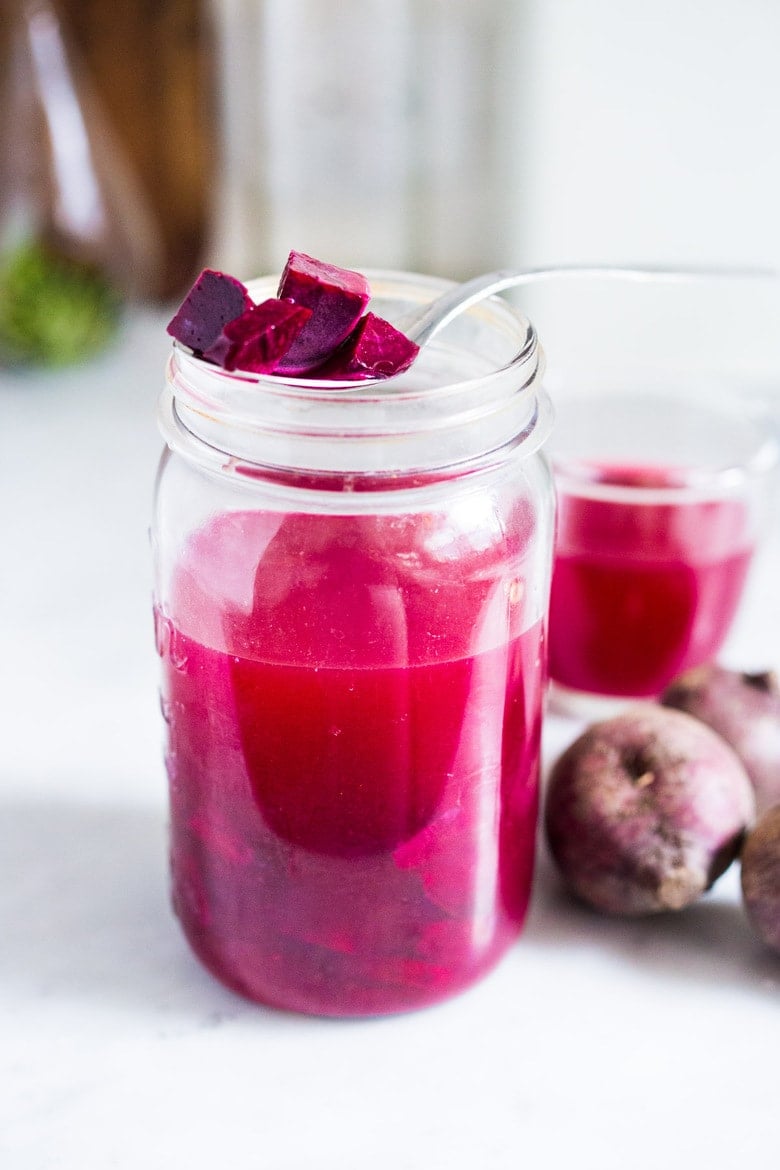
How to drink Beet Kvass
If new to fermented foods, start slowly. Drink a tablespoon first and see how you feel. You are adding millions of probiotics to your gut in just a tablespoon. This creates diversity in the gut, which is thought to be healthy! You could take a sip with every meal if you like, or take a shot once a day. I like to drink a shot in the afternoons for a refreshing pick-me-up. If it tastes too strong for you, you can water down the portion you are drinking. Yes, you can eat the beets!
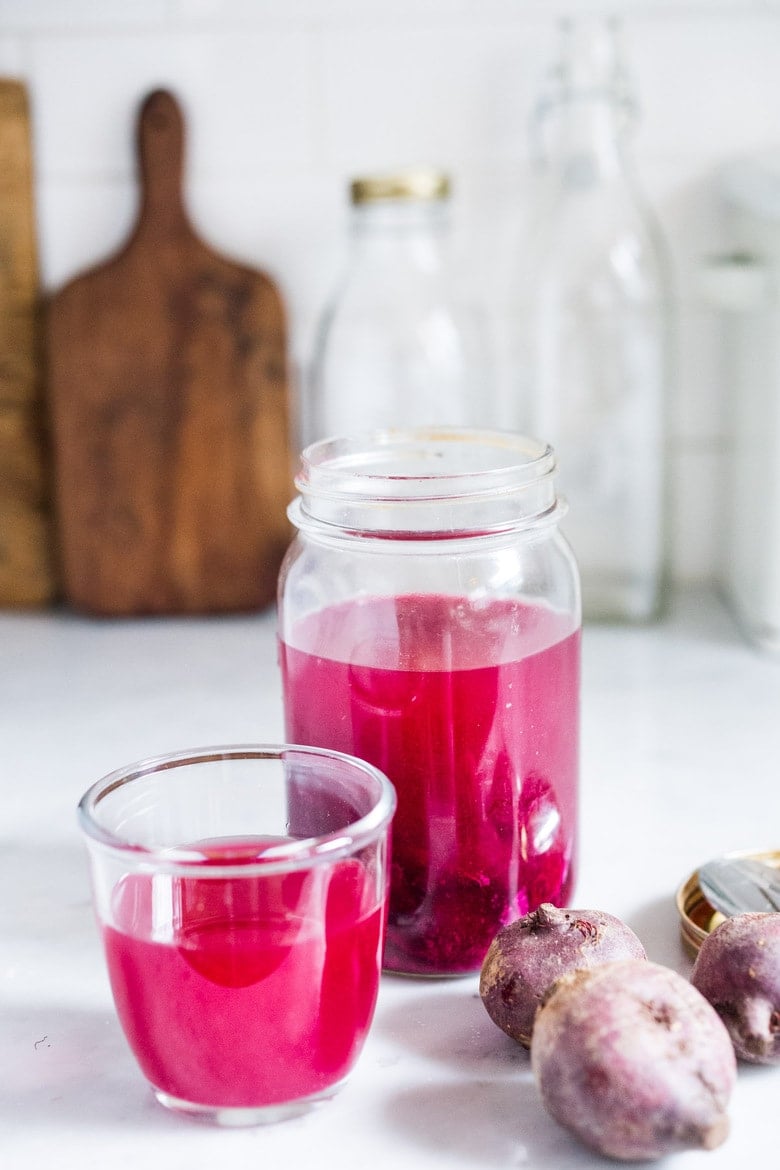
Troubleshooting
- If you notice any white foam on top of your kvass, or a cloudiness to the brine it is most likely kahm yeast and harmless. Skim it off with a spoon.
- If you see any mold, I would discard the batch.
- Beet Kvass should smell tangy and good like pickle brine – if it smells “off”, don’t drink it. A bad bacteria may have inadvertently been introduced – perhaps an unclean jar or utensils or dirty hands. It is easy to do.
- If your kvass is not tangy, it has not been fermented or not fermented long enough. This could be due to not using the right salt ratio or chlorine in your water.
More Fermented recipes you may like:
- How to Make Kombucha
- Probiotic Gut Shot
- 20+ Easy Delicious Beet Recipes
- Beet and Cabbage Sauerkraut
- How to make WATER KEFIR | an easy Guide!
- 25 Immune System-Boosting Recipes!
- How to Make Kimchi! A Quick Easy Authentic Kimchi Recipe
- How to make Sauerkraut (Simple Cultured Cabbage)
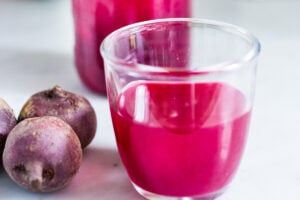
Beet Kvass Recipe
- Prep Time: 15
- Total Time: 15 minutes
- Yield: 1 quart
- Category: fermented
- Method: fermented
- Cuisine: Ukrainian
Description
How to Make Beet Kvass! An Eastern European probiotic drink made with beets, sea salt and water. Full of healthy probiotics from the Lacto-fermentation, Beet Kvass is believed to help boost immunity. It tastes slightly sweet, tangy, earthy and salty- but in a good way! With just 10 minutes of hands-on time,it is so simple- just let mother nature take its course. (Allow 2 weeks for fermentation- see notes for speeding up this process.)
Ingredients
- 2 medium beets, organic (see notes for doubling, recommended) 2 cups diced, skin ON.
- 3 cups filtered water (tap water may have too much chlorine & inhibit fermentation)
- 1 heaping tablespoon fine sea salt
Optional Additions:
- 1/4 cup fermented pickle brine or fermented kraut brine, or 1-2 tablespoons whey (liquid from strained yogurt)
- fresh dill (or fennel fronds), bay leaves, or other herbs.
- pickling spices ( fennel seed, coriander seed, dill seed, peppercorns, celery seeds, caraway, etc.) Tip: to prevent them from floating, either add them to the jar first, place beets over the top, or place a small mesh bag. Remove any that float to the surface.
- sliced onion or shallots
- fresh garlic cloves
- fresh sliced ginger or turmeric root.
Instructions
- Prep: Rinse and slice the beets into ¼-inch thick rounds, then dice them, leaving the skin on. You want that bacteria from the skin, so don’t peel! Get a clean, 1-quart mason jar.
- Assemble: If adding any whole spices, add these to the jar first, then add garlic, onion or dill if using. Add all the beets overtop. If adding whey, kraut brine or pickle brine, add this now.
- Make the brine: Mix 3 cups water with 1 heaping tablespoon sea salt. Pour this into the jar, leaving an inch of headroom at the top. If you need more brine: the ratio is 1 heaping teaspoon of salt, per 1 cup of water. Mix it first, then add. The salt will kill the harmful bacteria, but allow the healthy lactobacilli to flourish.
- Remove any spices or seeds that float to the top. Anything that touches the surface can mold. I check daily for floaters! Cover with a loose-fitting lid. Place in a bowl or baking dish (to collect any overflow- a sign of fermentation!).
- Ferment: Place the jar in a cool, dark place 60F-65 F is ideal. Check every couple days, removing seeds if need be. If you added whey or brine, you should see some action within 5-7 days. If not, it can take up to 2 weeks before you notice some slight bubbling when you tap the jar, indicating that it is fermenting. The longer it ferments, the more tangy it will taste, so you can ferment “to taste.” For an even tangier flavor, continue fermenting for 1-2 more weeks. Once happy with the flavor, refrigerate.
- Refrigerate (either strain, or leave beets in- I leave mine in). It will continue to ferment in the fridge, but at a much slower rate, developing more depth of flavor. The sugar from the beets will continue to feed the healthy bacteria.
- If you notice any white foam on top of your kvass it is most likely kahm yeast and harmless. Skim it off with a spoon and toss. If you see mold, I would discard the batch.
- Store this in the fridge, strain into a cup, and drink a few ounces daily. Yes, you can eat the beets!
Notes
This will last indefinitely in the fridge. I highly recommend making a double batch of this because of the longer fermentation time.
Flavor this up!!! I love adding onion, garlic and pickling whole spices. You can get small mesh cotton bags to put your spices in if you like, then no worries about “floaters.”
You can speed up fermentation significantly by adding a few tablespoons of whey ( liquid from strained yogurt) ¼ cup of fermented pickle brine or fermented kraut brine (make sure it is alive and bubbly- from the refrigerated section of the grocery store, not pickled with vinegar) to the jar.
Fermentation slows down in cooler places and speeds up in warmer places.
Nutrition
- Serving Size: ½ cup
- Calories: 20
- Sugar: 3.1 g
- Sodium: 1202.8 mg
- Fat: 0.1 g
- Saturated Fat: 0 g
- Carbohydrates: 4.3 g
- Fiber: 1.3 g
- Protein: 0.7 g
- Cholesterol: 0 mg



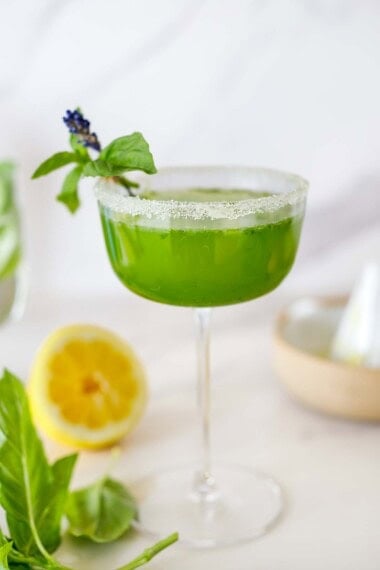
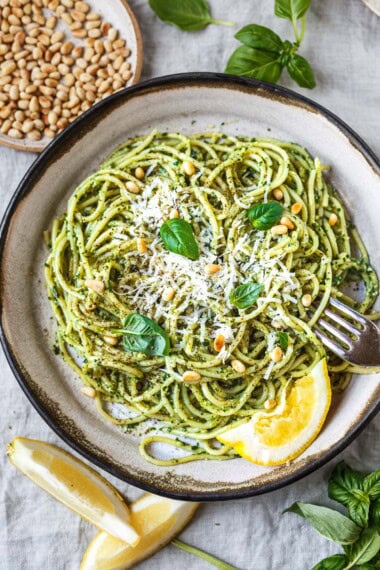

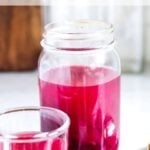
I made my kvass on Sunday. It had small bubbles on the surface for a few days but by Friday there were no bubbles. Smells good. But is it kvass? Seems like it did not ferment long enough. FYI I put it in a glass jar but it only filled about 2/3 of the jar (so lots of headspace). I sealed it tightly and have burped it twice a day.
Give it a try Karen- is it tangy? It will start to taste sour as it ferments.
Thank you! It tastes good (earthy and salty) but not tangy yet. I guess I let it keep fermenting? It is now on the 8th day.
I would, just till you get a little tanginess? Just to be sure it is fermenting.
If it has stopped fermenting, is there something you could do to get it fermenting again?
Hi Sarah- why do you think it has stopped fermenting?
Can the beets be eaten after fermentation and liquid is strained?
yes, they can!
Sounds good! Can’t wait to try.
Hi, we want to make your recipe and would like to add whey but we are not sure how much to put in.
Try 1/4 cup!
I made this recipe and kvass turned out great! I added garlic, ginger, and lots of different seeds you suggested in optional extras. Will try to keep making, my kids drink it faster than i can keep up and we eat the beetroot slices as condiment with food. Love it!
Great to hear! Do you add whey to get it started?
No i had some kvass i brought from markets, so i added about a tablespoon of that.
No i used about a tablespoon of beet kvass i bought at market.
Great idea!
Can I blend beet kvass and drink it immediately as juice,I just want to detox my liver?
I have never tried this blended. The beets may not be soft enough here?
Can’t wait to try this after bingeing on Eastern European YouTube videos! I will use some liquid from my pickled beets/carrot/daikon which are almost gone. Ginger will be my add in. Seems like you could perpetuate the brine by innoculating the new batch with the previous, alá sourdough. What do you think?
yes, I think that would work great!
I just made my first delicious batch and am wondering if the same beets can be ‘ kvass-ed’ again?
There seems to be some debate about this on the web. Thank you
Great question, and I actually don’t know! Have never tried this! If you do try it- let us know. Did you use whey?
I did not use whey.
Today is our 2 week mark so I tried it, and all I taste is salt with a little bit to beets. Is it supposed to be tangy? Is it supposed to still be very salty?
It should be tangy yes. If not, it may not have fermented. Yes, it will still be salty but it should have a bit of tangy or pickle juice smell and flavor. You could try letting it go another week, sometimes this one takes a while. Or you could add a couple of tablespoons of whey ( from yogurt).
I’m hooked on beet kvass, but right now I can’t get fresh beets. Has anyone tried making it with canned beets with maybe cabbage or saurkraut added
I’ve only made with fresh beets.
Why did my beet kvass grew mold on top despite house is cool temp? I’m in San Francisco.
Hummm. Were the beets or spices exposed to air on top? That may be why.
Hello, I like to add some chillis to make my kvass spicy:)
Love it!
Kvass is not only made in Ukraine (please do not say The Ukraine) but has origins in many Slavic countries, like Russia, Poland, Belarus, Hungary and the word means Sour.
Thanks for the clarification. 🙂
Hungary is not Slavic
May I add sugar or a fruit like orange or raspberry? Maybe an apple 🍎?
I don’t see why not? The drink is traditionally salty, like brine though.
Do you think this will work if I live in an apartment that gets really hot, often reaches degrees of 85 F? If not, any suggestions for a “dark cool place”? Thanks!
That may be too hot. Lower cabinets away from stove or appliances tend to be cooler.
Thanks!
so excited, will have to wait to see how it turns out, but I have a lot of beets right now and am kavass curious. thank you for putting this out!
Will it get bubbly? I am looking to make a bubbly vegan drink without ginger bug or honey.
I havent been able to get mine bubbly. Have you tried the Water Kefir?
I didn’t see where it says how much whey to use.
I use about 1/4 cup.:)
Can you eat the strained beets?
Yes!
Sounds good as soon as my beets from my garden are ready I’ll try it.
What’s your suggestion for amounts of the spices? I have been making my own for a while now and want to experiment with spices. Thanks.
2-3 tablespoons per 4 cup jar? Its very flexible!
I’m looking forward to making this and have all the ingredients! I am going to use a quart size wide, mouth Mason Jar, but I’m not sure if that type of lid and ring are going to work for the fermenting? Thoughts? Thanks! KK
It should be fine. You won’t need the ring, just place the lid on top.
OMG this sounds awesome! Going to the store today to get the beets. I love.pickle juice!
Hi, I have made kvass and I use cabbage as well, also add a probiotic starter to get more goodies in there. Sometimes I use golden beets with some orange rind and Inca berries added, not quite as strong as the red.
Love it- will have to try that!
I am so excite to make this. My grandmother used to swear by this and she lived until she was 98! Will give it a go.